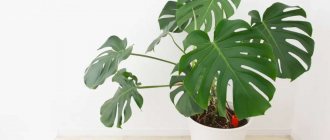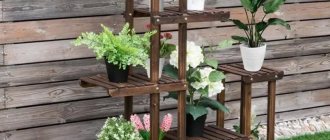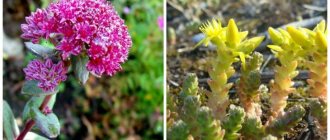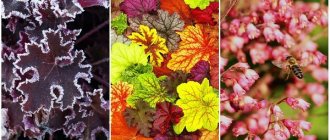Each of us tries to make our home more comfortable and cozy. Flowers add undeniable comfort to any apartment or house, and it is also useful, because indoor plants perform the function of purifying the air. Archaeological science, based on pollen found in caves, has proven that even in the Stone Age, people decorated their homes with flowers. Today, indoor floriculture is a separate science, and from all the variety of house plants, we present the most beautiful indoor flowers.
18 most beautiful types of indoor flowers:
1
Clivia
The beautiful evergreen plant is named after Duchess Charlotte Clive, who was governess to the future Queen Victoria of Great Britain.
This flower arrived in Europe from South Africa, easily took root in northern latitudes and became a favorite of most gardeners.
An unpretentious plant will decorate any home or office space, but you must try not to move the pot and water it once a week.
2
Ampelous indoor plants (photos and names)
This section is about house flowers, which have long, hanging, flexible shoots that can either stretch upward or crawl along the ground. We came up with three interesting flower names with photos to familiarize yourself with these types of plants.
Columnaea (lat. columnea)
Fragile stems droop and hang down. The smooth leaves of this evergreen plant are small, elliptical, and have some pubescence. In spring, bright red flowers of 7 cm with a yellow throat begin to bloom. Columnaea flower looks like a hood.
Columnea
Columnia with yellow flowers
Columnaea likes to stand in partial shade, but diffused lighting is also suitable. Successful cultivation is guaranteed in the absence of drafts and the following watering regime: 3 times a week in the summer and 1 time in the winter.
IMPORTANT
Columnia is demanding of high air humidity!
This beauty grows up to 90 cm in length and lives in greenhouse conditions for 5 years.
Rhoicissus
The plant is popularly called “birch tree”. There are many types of rhoicissus, in general they are distinguished by rhombic-shaped leaves. The plant belongs to the grape family; its resemblance to a vine is enhanced by long shoots with tendrils that cling to the support.
The plant is unpretentious, with good lighting and lack of waterlogging it grows quickly.
The leaves consist of several rhombic leaflets, the underside is covered with fleecy pubescence, the upper side is emerald green and smooth. Unpretentious plant
Ivy (lat. Hedera)
Known, perhaps, to everyone: the flower is unpretentious, shade-tolerant and easily propagated by cuttings. The plant in nature reaches 30 m, but even in an apartment it can completely wrap around a support or window.
Ivy
Ivy hanging in a pot
The plant does not like direct sunlight and moving the pot. All species have some differences in leaf shape. They can be pointed, star-shaped, or oval.
Ivy grows well in moderate light and regular watering during the warm season.
Crassula
The round leaves of this plant look like coins, which is why Crassula is often called “money tree” or “crassula” among gardeners.
When it blooms, it is covered with small white flowers, sometimes red, and very, very rarely the flowers can be blue.
One of the most unpretentious room dwellers. Even a leaf that falls to the ground can sprout into a separate plant.
3
Lithops
Photo credit: Dornenwolf / flicr
Translated from ancient Greek, the name of the plant translates as “stone appearance,” perhaps because it comes from the rocky and sandy deserts of Namibia and Botswana.
That is why Lithops has learned to retain moisture and easily tolerate heat and arid climates.
The flowers of the desert dweller who migrated to apartments are white or yellow; very rarely there are varieties with orange petals.
4
iNaturalist
Another application similar to PlantNet. Developed by scientists at the University of California, Berkeley. It can recognize plants, insects, animals and birds. It is mainly designed for work “in the field”, but also copes with house plants.
Take a photo of your indoor plant, then click on the “View Offers” button. The program will display the most likely options for its name. If the plant is identified correctly, you can upload it to the database and provide a description to help other users.
The application is free and has no restrictions. True, it does not recognize rare species very well, but it is still worth a try.
iNaturalist
iNaturalist
Price: Free
Download
Price: Free
Croton
This species, growing in tropical and subtropical zones, has long become popular among flower growers around the world.
Its bright leaves will add variety and uniqueness to your home, or will become a real decoration for your office. Due to its shape it has become very popular among amateur gardeners.
The plant is easy to care for, and some of its species grow up to 80 centimeters in height.
5
My flower garden!
Entry from 07/09/2015 Author Irina
Nephrolepis, agave and orchid
The bulk of plants used in indoor landscaping come from countries with tropical and subtropical climates. Most of them grow in conditions of high, even temperatures and heavy rainfall. These include ficus trees, many palm trees, begonias, philodendrons, peperomia, and arrowroot. Others are inhabitants of mountain forests of the tropics, characterized by a cooler but humid climate and constantly high air humidity (ferns, orchids, many bromeliads, etc.). Some live in seasonal deciduous and semi-deciduous forests of the tropics, in areas with a clear annual change of rainy and dry periods (Australian eucalyptus, acacia). Aloe, milkweed, Kalanchoe, Gasteria, and Haworthia come from the extremely dry regions of Southern and Eastern Africa with scanty, irregular rainfall. The homeland of cacti and agaves, well known in indoor culture, is the dry mountain plateaus of Mexico, Central and South America. The variety of natural conditions in which the houseplants known to us grow in their homeland determines the diversity of their appearance, biology, and developmental rhythms. Some of them are grown for their spectacular flowers, others for their beautiful, interestingly shaped and colored leaves, and others for decorating vertical walls. Some plants attract the attention of gardeners with their unusual shape and structure.
Depending on the decorative properties of plants, their morphological characteristics, ecology and possibilities of use in the interior, the entire variety of indoor plants can be divided into several groups. 1. Decorative flowering plants . This is a relatively small group of plants that are grown exclusively for their beautiful, spectacular flowering. It can last from a week to several months. Pelargoniums, begonias, and Saintpaulia bloom for a long time and abundantly. Short-term flowering in clivia, crinum, hippeastrum. Some of these plants bloom in winter (azaleas, camellias, poinsettias, cyclamen), others in spring and summer (pelargonium, sinningia, achimenes, bellflower). The rest of the time these plants are unattractive.
Tuberous begonia, orange Chrysanthemum - autumn flowering Saintpaulia - indoor plants for long flowering
2.
Decorative leaf plants . Most indoor plants belong to this group. They attract gardeners either by the beautiful shape of the leaves (palms, ferns, philodendrons), or by their unusual bright or variegated color (begonias, arrowroots, codiaeums, many acanthaceae). When growing variegated plants, it is important to know how each of them reacts to light. Some prefer shaded areas; with excess light, their leaves become pale, light, and lose their variegated pattern (begonias, arrowroots, scindapsus). In others, on the contrary, the variegated color of the leaves is more pronounced in light sunny conditions (codiaeums).
Bocarnea - decorative foliage indoor plant
3. Lianas . These plants require constant support to grow successfully. They have long herbaceous or woody stems, equipped with various devices for attachment to a support. In some plants, the stems twine around a support (asparagus), in others they cling to it with tendrils (passiflora, gloriosa). Many climb up trunks or vertical walls using adventitious roots (ivy, philodendrons).
Some rest on the trunks and branches of neighboring trees, thus maintaining an upright position (bougainvillea). Lianas are used for vertical gardening of walls and columns in large rooms. They are good to shade a sunny window or, by installing a flower girl with a lattice entwined with them, to fence off part of a room or a corner in the lobby of a boarding house. When using vines in interior design, you need to consider the way the plant is attached to the support. For vines with climbing stems and stems equipped with tendrils, place a wooden lattice and stretch a string. Species with sucker roots are easily fixed on a vertical wall, trimmed with tuff, on a stick wrapped in sphagnum moss, a piece of bark or wood.
Passionflower - liana
4. Ampelous plants . These are plants with long hanging shoots, cultivated in hanging pots and baskets. Their very name comes from the German word Ampel, which means hanging flower vase. Small vines are used as hanging vines - scindapsus, cissus, tradescantia, as well as plants with initially erect, and later drooping or hanging stems (setcreasia, eschynanthus, many peperomia). Some rosette plants capable of forming tendrils (shoots with long internodes ending in small rosettes) - chlorophytum, saxifrage, episcia - are grown in hanging pots. Some ferns with long hanging leaves (nephrolepis) look impressive when hung in baskets. Canopy plants and vines can also be used in winter gardens as ground cover plants.
Chlorophytum - hanging plant
5. Epiphytes. The name itself from the Greek words epi - on and phyton - plant speaks of the lifestyle of these plants. They settle on tree trunks and branches, using them only as support, but not parasitizing them. Living high in the crowns of trees, epiphytic plants find themselves in conditions of favorable lighting, but a constant deficiency of moisture and nutrients. Most epiphytic plants capture moisture from the air and rainwater with the help of aerial roots equipped with special spongy tissue. Others (most bromeliads) absorb moisture with scale-like hairs that densely cover the leaves. In addition to orchids and bromeliads, many ferns (platycerium, asplenium), gesneriaceae (columnaea, aeschynanthus), some peperomia and cacti (rhipsalis, selenicereus, epiphyllum) lead an epiphytic lifestyle. Many epiphytic plants can also grow successfully on rocks and rocks that are mossy or completely bare. In this case, they are called epiliths (from the Greek lithos - stone). Under cultural conditions, epiphytes can be grown as terrestrial plants in pots in a loose, air- and moisture-permeable substrate; on driftwood or in special blocks of oak, pine or birch bark, screwing the plants to the support with soft braid. A small dry tree or branched snag with several epiphytic plants attached to them can serve as the best decoration for a winter garden or window flower display.
Orchid is an epiphytic plant
6. Succulents (from Latin succus - juice) . This is a large group of plants with succulent, fleshy stems or leaves of often bizarre shapes - spherical, spindle-shaped, rolled, in the form of flat cakes or green bulbs. It includes cacti, euphorbia, agaves, aloe, gasteria, haworthia, calaichoe, crassula, sedum and many others.
Cactus - succulent plant
They come from areas with extremely dry climates, where periods of drought last for several months (in some areas there may not be any rainfall during the year). They store the meager moisture that these plants receive with rare rains, night dews and fogs in stems and leaves.
Source - Houseplants: a reference book // Edited by Golovkin B.N.
Did you like the article? Share with friends
RќСЂР°РІРёС‚СЃСЏ
General questions about plant care
- ← Callistemon rod-shaped from seeds and cuttings
- Agricultural technology for indoor plants - watering →
Bromeliad
They named the indoor flower and the entire genus in honor of the Swedish biologist Bromelius. This tropical beauty is a distant relative of the pineapple.
Their leaves are lancet-shaped, they are collected in a kind of rosette from which the peduncle grows. Bromeliads require watering only once a week, but bromeliads should be placed in places that receive sunlight.
Flowering lasts from 3 weeks to several months, delighting the owners and guests of the house.
6
Sun-loving, beautifully flowering indoor plants
To choose a place for indoor plants, it is sometimes useful to know where their homeland was. And if the flower came from the equatorial zone, but grew under the cover of the jungle, then it will easily tolerate shading. But if the plant’s homeland was an open sunny space, then without a daily dose of sunlight, success will not be achieved.
Let's look at the photo and learn more about some indoor plants that are lovers of sunbathing.
Primrose (lat. primula)
A perennial flowering plant with evergreen leaves up to 15 cm long. The foliage is corrugated and forms a rosette.
Bright primroses
The inflorescences are collected in umbrellas or solitary, the corollas are double or simple. There are varieties that combine a silvery coating on the petals and two-color petals or a bright core. There may be no smell.
In order for the flowering to be bright and long, it is better to choose the lightest place and water it in such a way that the soil is always moist. The leaves themselves cannot be watered.
It is better to place the pot on wet gravel. Primrose loves geranium soil and fertilizers.
IMPORTANT
After the plant has flowered, it is transferred to partial shade.
Fuchsia (lat. fuchsia)
They are evergreen or deciduous, erect or may have drooping stems.
The flowers resemble small, up to 8 cm, lanterns and are pleasing to the eye from mid-May until the first frost. Color range: white, pink, red, pink-lilac, purple, combining two colors. The leaves are oval, matte, located opposite on red stems. The edges of the leaves are serrated.
Magic fuchsias
The plant loves a certain amount of direct sunlight, so you need to place the pot where the sun shines in the first or second half of the day.
Watering depends on the air temperature, but the substrate should dry out between waterings. The plant is sprayed twice a week. Replanting is needed annually, and young plants need to be replanted several times a season into enriched garden soil with sand.
In summer, fuchsias are usually taken outside into some shade.
ATTENTION!
During flowering, fuchsia must not be rotated or rearranged!
Persian cyclamen (lat. cyclamen persicum)
Herbaceous tuberous plant with a long flowering period. The flowers are admired during the cold season: the magical bent flowers of white, pink, and red tones begin to bloom, usually in November, and end in March-April. The leaves are heart-shaped and dark green in color with a beautiful whitish-silver pattern.
Cyclamen blooms very vigorously Cyclamen
Cyclamen loves direct sunlight while flowering.
Replant in the fall in deciduous humus with sand and peat.
It is difficult to make cyclamen bloom again in an apartment, however, with the help of annual replanting and regular fertilizing, the plant continues its life cycle.
Geranium
This beautiful indoor plant also has bactericidal properties, so it will not only decorate the room, but will also be useful.
In order for geraniums to bloom constantly, it is necessary to pick off the already fading flowers.
The plant is unpretentious and does not require spraying or frequent watering. Because of its beauty and originality, geranium is one of the most popular inhabitants of apartments and offices.
7
Fruit houseplants, their photos and names
There are indoor indoor plants that will not only decorate your living space with their appearance, but will also bear edible fruits. Here are the names and photos of some fruit-bearing indoor plants: lemons, tangerines, kiwi, figs, pineapple, mini peppers and even pomegranate.
Indoor lemon
It differs from its relatives in dwarf varieties that bear fruit in apartment conditions and bear up to 20 lemons. Indoor lemon smells very strongly, corresponding to its name, and is very decorative, because it does not have a dormant period, and on the tree you can always see green glossy foliage and flowers, and lemons.
The plant needs additional lighting and warmth, but it is better to cover heating devices, if they are nearby.
Indoor lemon
Figs
In the house it begins to bear fruit in the first year. They care for figs just like lemons, but remember that the tree sheds its leaves at the end of October. A rest period is required; it is tedious to move the figs to a cool place and shade them with a dark cloth. It is good to lower the tree into the basement and water it as little as possible. After a while, the plant will begin to develop new buds, which means it’s time to return the figs to the bright windowsill.
Figs
We covered a very small part of the catalog of indoor plants, but we hope that our article turned out to be informative and educationally useful.
Alocasia
The exotic queen of the tropics has just begun to win the hearts of sophisticated flower growers. Unusual, original shaped alocasia leaves will decorate any room.
In addition, it is unpretentious and does not require special care. Interestingly, different species have different numbers of leaves, but during flowering many plants have only one leaf.
In nature, some species grow up to 2 meters in height, but domestic relatives are from 20 to 40 centimeters.
8
What indoor palm trees look like: photos, names
Indoor palms can come in different sizes and have a wide variety of leaf shapes. They grow rather slowly, so you should not hope that its size will increase very quickly. Indoor palms can be pinnate or fan-leaved.
Date palm
There are about 17 species of date palms. "Finger date" is a houseplant that has a shaggy column-shaped trunk and can grow right up to the ceiling. It is this palm tree that can be grown by planting the seed of an ordinary dried date in a flower pot. However, it is better to take an inedible date for this purpose.
Areca
Areca is an extremely interesting palm tree with a flexible trunk on which a large number of scars can be seen. The crown consists of a bunch of beautiful leaves. Areca can grow up to 2 m indoors.
coconut trees
The coconut palm is not the best representative for growing at home. The exceptions are the nut-bearing coconut, Foster's howea, Belmore's howea, Hamerops squat and Liviston palm.
Spathiphyllum
According to legend, this beautiful home flower helps girls meet their betrothed and find feminine happiness.
But with such abilities, it requires special attention to itself, and one cannot say that these are unpretentious indoor flowers. It does not like drafts, but it is better to water it using the cycle method with settled water.
During its flowering period it requires more moisture, but the sun is not so important for it, so it can also grow on windows facing north.
9
Indoor rose
What could be more beautiful than a rose, especially when it blooms on your windowsill. But this queen of flowers requires special care.
The home rose simply loves sunny color, so it is better to place it in a well-lit place on a western or eastern window.
If you care for them properly, roses will bloom all year round, every 7-8 weeks.
10
Fuchsia
Once upon a time, flowering indoor plants accepted fuchsia, a native of Australia and Latin America, into their family. And what is noteworthy is that she immediately took a leading position in home floriculture.
This flower was also revered by the American Indians, and the Incas considered it sacred and decorated their homes and places of worship with flowers.
Fuchsia is unpretentious, and the only thing it really loves is the diffused sunny color. On the pages of the website most-beauty.ru we wrote about this plant in an article about the most beautiful flowers in the world.
11
Hibiscus
But this is not really a flower, but a shrub that came to the Old World from the hot tropics. Evergreen hibiscus, blooming from early spring to late autumn, will decorate the room.
It should be kept in the southern part of the house, where there is a lot of light, and watered regularly and preferably with settled, not cool water.
The only thing that this most beautiful of shrubs cannot tolerate is sudden temperature changes and drafts.
12
Selenicereus
This plant belongs to the genus of cacti that came from the forest and rocky areas of South America. The body of Selenicereus is represented by thin multi-ribed flowing shoots, on which aerial roots-trailers are formed, with the help of which the plant is strengthened on any supports.
In mid-spring, flower buds begin to form on the shoots. They are small fluffy balls that gradually grow and turn into huge buds. Flowers up to 35 cm in diameter open in the evening, filling the space with a thick vanilla aroma. The flowers consist of multiple white petals with gilded sepals.
Flowering lasts only one night.
How to properly care for the plant:
- Selenicereus prefers brightly lit places and easily tolerates the influence of direct sunlight, but reacts painfully to the slightest drafts and sudden temperature changes.
- Watering should be carried out as needed - after the soil has completely dried. The plant does not need spraying, but periodically you should give it a light warm shower to wash off the dust.
- Selenicereus should be planted in a fertile, but light and loose soil mixture. Soil is good for cacti.
Hippeastrum
Often this representative of indoor fauna is mistakenly called Amaryllis; in Greek it is a combination of two words “horseman” and “star”.
A flower with a romantic name loves bright light and is very thermophilic. This is not surprising, because he arrived in Europe and America from the warm latitudes of South Africa.
When flowering, it produces magnificent bright red or pink corolla-shaped flowers.
13
Hyacinth
This house flower, a member of the large Asparagus family, can bloom in a variety of shades from bright red to white and purple.
Recently, due to its original shape and beauty, it has become a fairly common species among gardeners. In addition to the house, there are species that get along well in the garden.
Hyacinth flowers are widely used in the perfume industry, and during the flowering period, hyacinth itself has a pleasant aroma.
14
cacti
Be that as it may, but a prickly flower during the flowering period, even if this happens very rarely, you simply cannot take your eyes off them.
And it can please you with flowering only with proper care and compliance with watering requirements. Everyone probably knows that cacti are not watered in winter.
This is a heat-loving plant, so it loves bright light and prefers to be in the southern part of the house.
Begonia
Graceful and majestic begonia has long won the hearts and souls of flower growers and lovers of beauty. It is noteworthy that leaves and flowers can take on a variety of, and sometimes quite bizarre, shapes.
Loves sunny color and regular watering. With proper care, it will delight you with the blooming of beautiful colorful flowers.
This genus is the most common and numerous in the large Begonieceae family, and somewhere in space there is an asteroid named after this flower.
16
Unpretentious indoor plants, their photos and names
Kohleria (lat. isoloma (kohleria))
A plant that blooms all year round with velvety tubular red or orange flowers is considered one of the most low-maintenance plants. Green, slightly pubescent, with fine teeth, the leaves perfectly set off the beautiful flowers.
Kohlerias love light partial shade and watering during the growing season and flowering once every 3 days.
The plant grows 60 cm and lives up to 3 years.
IMPORTANT
Leaves do not tolerate water.
Tradescantia
The undeservedly forgotten American plant has dozens of varieties and a common structure for all types: Long straight shoots with numerous branches represent a rather massive bush. Green, silver, purple with veins, striped Tradescantia blooms with small flowers also of different colors.
With moderate regular watering and placement in diffused sunlight, such a plant can delight for many years. Pruning only improves the appearance of Tradescantia.
Spathiphyllum Wallis (lat. spathiphyllum wallisii)
This plant with its 30-50 cm leaves on long petioles is very similar to a lush bush. The decorative qualities of spathiphyllum are beyond praise. White flowers with soft yellow, beige or white-green spadix appear throughout the year.
Spathiphyllum Wallis looks great when there is a lot of it
Spathiphyllum Wallis Spathiphyllum grows in bright, diffused light and regular watering. It is best if the substrate is always moist and without stagnant water. With feeding and proper care, the plant lives for 10 years.
Tips for a florist: how to care for the “Women’s Happiness” flower or spathiphyllum In a special publication on our portal, we will tell you in detail about the flower, which is called “Women’s Happiness,” how to properly grow, propagate, feed and pruning, and what problems you may encounter.
Poinsettia
The first Spaniards who arrived in South America met a beautiful flower in the tropics, and local ethnic groups spoke about its healing and magical properties.
The second name simply screams about the magnificence of the plant - the most beautiful Euphorbia, and today it is widespread as an indoor flower in every corner of the world. For a long time there was a misconception that the plant is poisonous, but this is not so. It is harmless and even useful, ionizing the air in the room where it grows.
17
Google Lens
The most obvious way to look for unknown plants is to use Google. Basically, you can just take a photo of a flower and upload it to Google Images and see what the search engine can find.
But it will be much faster to search by photo using Google Lens. This application has a special mode for recognizing plants and animal breeds - this is what we will need.
Point your smartphone camera at the object and when a colored circle appears on the screen, click on it. Google will find similar options on the web, and if you're lucky, you'll figure out the name.
Google Lens does not always correctly recognize rare plants, but its capabilities will be sufficient to search for common species.
Google Lens
Google LLC
Price: Free
Download
Price: Free
Schlumberger
A flower with such an unusual name belongs to the cactus family, but among gardeners there are many names: “Decembrist”, “Christmas cactus” or simply “Christmas cactus”.
When it blooms, it usually blooms very luxuriantly and for a long period of time. It is better to place it in bright places, but without direct sunlight. Like all cacti, it requires moderate watering, but during the flowering period it is necessary to water it abundantly and maintain high air humidity.
18
Decorative foliage indoor plants, their photos and names
This group is characterized by diversity in foliage color and patterns and minor flowering. These indoor plants are considered practically non-flowering. We suggest looking at their photos and finding out their names.
Climbing
Monstera deliciosa (lat. monstera deliciosa)
These are climbing vines of impressive size. Even the laziest gardener can grow a monstera, since it needs abundant watering, but once a week in the summer, and 2 times a month in the winter. A pot with such a vine will be comfortable in partial shade or in diffused light. Once a week, the huge carved dark green leaves should be washed with a damp cloth.
Monstera
The plant still blooms, but the flowers are expressed by cream-colored cobs.
IMPORTANT
Monstera needs support, as it grows 3 meters upward and reaches 1.5 m in width.
Upright
Araucaria (lat. Araucaria)
It can replace the New Year tree with its delicate needles. Tree-like plant, branches arranged in tiers. The older the tree, the darker the needles. The plant does not produce cones in indoor conditions.
Araucaria should grow in a bright place, out of direct sunlight. The plant loves abundant weekly watering in winter, more frequent in summer.
ADVICE!
Araucaria should not stand next to heating appliances.
For this coniferous beauty, it is better to choose a long-lasting granular fertilizer for conifers.
Interestingly, at home the tree will not exceed 3 m, but in natural conditions you will be surprised to see a 60-meter Araucaria.
Croton (lat. codiaeum)
One of the most spectacular plants in appearance. The amazingly colored leaves look like blades and can be rounded or pointed at the ends. Colors that can be simultaneously seen on croton leaves: green, yellow, orange, red.
Croton
The flowering is completely inconspicuous. Croton grows on western windowsills to receive direct sunlight in the evening. In winter, water the plant less, allowing the substrate to dry out, and in the warm season, water frequently and abundantly. A handsome adult occupies a space of 1 meter around him. Dimensions of croton (codiaum): up to 1 m in height and width.
ADVICE!
Young shoots should be pinched for greater bushiness.
Primrose
Let’s complete the review with a representative of the Primrose family, the most beautiful and original flower, Primrose. The name in Latin is exactly that - “first”.
Whole, carved leaves form a basal rosette. But the primrose blooms with multi-colored flowers of bizarre shapes and an incredible aroma.
It is best to place primroses in brightly lit places, but without direct sunlight, in the southern part of the apartment or house.










